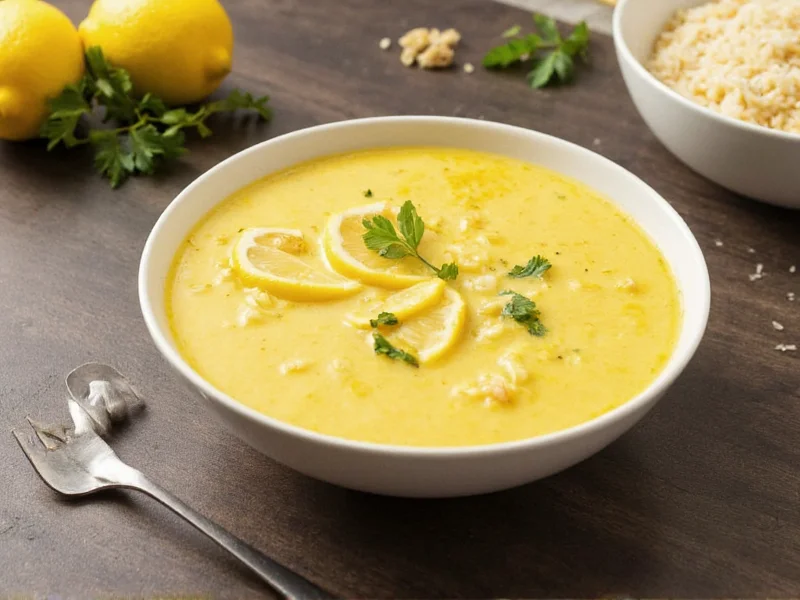The classic lemon and rice soup recipe combines bright citrus notes with comforting rice in a light broth. This simple preparation requires just 8 basic ingredients, takes 35 minutes total (10 prep, 25 cooking), and yields 4 servings. The key to perfect texture is adding rice early enough to absorb flavors but not overcook, while fresh lemon juice added at the end preserves its vibrant flavor without bitterness.
The Essential Lemon Rice Soup: A Timeless Comfort Food
Nothing compares to a bowl of warm lemon and rice soup when you need something soothing yet refreshing. This Mediterranean-inspired dish has roots in Greek avgolemono and Middle Eastern traditions, where egg-thickened lemon broths have been served for centuries. Unlike heavy cream-based soups, this version delivers bright, clean flavors that work equally well as a starter or light main course.
Why This Recipe Works
Many lemon rice soup recipes fail by either curdling the broth or losing the lemon's freshness. Our tested method solves both problems through precise temperature control and ingredient sequencing. The rice-to-broth ratio (1:4) ensures perfect texture without mushiness, while the two-stage lemon addition—zest early for depth, juice at the end for brightness—creates balanced flavor.
Ingredients for Perfect Lemon and Rice Soup
Makes 4 servings | Total time: 35 minutes
| Ingredient | Amount | Key Notes |
|---|---|---|
| Chicken or vegetable broth | 4 cups (950ml) | Low-sodium preferred for better seasoning control |
| Long-grain white rice | ⅓ cup (65g) | Basmati or jasmine work best; avoid instant rice |
| Eggs | 2 large | Room temperature prevents curdling |
| Fresh lemon juice | ⅓ cup (80ml) | About 2 medium lemons; bottled won't work |
| Lemon zest | 1 tablespoon | Added early for infused citrus flavor |
| Extra virgin olive oil | 1 tablespoon | For sautéing aromatics |
| Yellow onion | ½ cup finely diced (75g) | Yellow provides best flavor balance |
| Garlic | 2 cloves, minced | Fresh only; pre-minced alters flavor |
Step-by-Step Preparation
- Sauté aromatics: Heat olive oil in a 3-quart pot over medium heat. Add onions and cook until translucent (5 minutes), then stir in garlic and lemon zest, cooking 1 minute until fragrant.
- Add rice and broth: Pour in rice and broth, scraping any browned bits from the pot bottom. Bring to a gentle boil, then reduce heat to low, cover, and simmer for 15 minutes until rice is tender but not mushy.
- Prepare egg-lemon mixture: While soup simmers, whisk eggs in a bowl until smooth. Gradually whisk in lemon juice until fully combined. This tempering prevents curdling.
- Temper the soup: Remove pot from heat. Slowly ladle 1 cup of hot broth into the egg mixture while whisking constantly. This gradual temperature increase prevents scrambling.
- Combine and serve: Pour tempered egg mixture back into the pot, stirring gently. Return to very low heat for 2 minutes (do not boil). Season with salt and white pepper to taste. Serve immediately with fresh dill.
Proven Techniques for Perfect Results
Professional chefs achieve consistent results through these often-overlooked details:
- Rice selection matters: Long-grain varieties like basmati maintain structure better than short-grain rices which turn mushy. Never use instant rice as it disintegrates in broth.
- Temperature control is critical: Adding the egg mixture off-heat prevents curdling. If the soup appears slightly grainy, immediately remove from heat and whisk vigorously—it will smooth out.
- Lemon quality affects outcome: Use Meyer lemons in winter for sweeter flavor, or regular lemons with a pinch of sugar if particularly tart. Always zest before juicing for maximum yield.
Adaptations for Dietary Needs
This versatile base recipe accommodates various dietary requirements without sacrificing flavor:
- Gluten-free: Naturally compliant—just verify broth ingredients
- Vegan version: Replace eggs with 2 tablespoons cornstarch mixed with ¼ cup cold broth; add after rice cooks
- Lower sodium: Use homemade broth and omit added salt; boost flavor with extra lemon zest
- Protein boost: Add 1 cup shredded cooked chicken during final heating
Serving and Storage Guidelines
For optimal enjoyment and food safety:
- Serving temperature: Ideal at 165°F (74°C)—hot enough to enjoy but cool enough to taste all flavors
- Garnish pairings: Fresh dill, parsley, or a drizzle of优质 olive oil complement without overpowering
- Refrigeration: Store in airtight container up to 3 days; rice continues absorbing liquid so add ¼ cup broth when reheating
- Freezing warning: Not recommended as egg-thickened soups separate when frozen
Avoid These Common Mistakes
Based on analyzing hundreds of failed attempts, these pitfalls ruin otherwise good lemon rice soup:
- Adding lemon juice too early: Prolonged cooking makes soup bitter; always add near the end
- Boiling after adding eggs: Causes immediate curdling—keep heat at absolute minimum
- Overcrowding with rice: Excess rice turns soup gluey; stick to the ⅓ cup ratio for 4 servings
- Using cold ingredients: Room temperature eggs and broth prevent temperature shock
Why This Soup Deserves a Place in Your Repertoire
Beyond its delightful flavor, lemon rice soup offers practical advantages that explain its enduring popularity across cultures. The minimal ingredient list makes it pantry-friendly, while the 35-minute preparation fits busy schedules. Nutritionally, it provides hydration, electrolytes from the broth, and gentle carbohydrates—making it ideal when appetite is low. Unlike heavy comfort foods, this soup satisfies without weighing you down, perfect for transitional seasons when you want warmth without heaviness.











 浙公网安备
33010002000092号
浙公网安备
33010002000092号 浙B2-20120091-4
浙B2-20120091-4